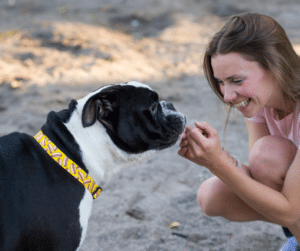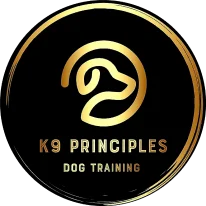Teaching a dog their name is one of the foundational elements of effective dog training. This step ensures clear communication between you and your dog, setting the stage for all future training and behaviour management. Whether you are working with a new puppy or an older dog, teaching them to recognise and respond to their name is essential. In Hamilton, dog owners looking for professional guidance on this and other dog training techniques should consider K9 Principles, known for offering personalised, expert-led dog training in Hamilton.
Why Is Teaching a Dog Their Name Important?
Teaching a dog their name is essential not only for basic communication but also as the cornerstone of successful dog training. By learning their name, your dog becomes more receptive to additional commands like “sit” or “come,” which are vital in maintaining good behaviour and ensuring safety in various environments. For dog owners in Hamilton, this is especially important as busy city environments can present numerous distractions and challenges. Having your dog reliably respond to their name is the first step towards more advanced Hamilton dog training techniques.
A strong bond between a dog and its owner is built through clear communication. By teaching your dog their name, you strengthen this bond, making future training easier and more effective. When working with professional trainers like K9 Principles, name recognition is often the first stage in comprehensive dog training programs.
When to Start Teaching a Dog Their Name
The earlier you begin teaching your dog their name, the better. Puppies as young as eight weeks old are typically ready to start learning, and their natural curiosity and eagerness to please make them fast learners. However, even older dogs can successfully learn their name with consistent training. In situations where dogs have previously been called by a different name, patience and positive reinforcement will be key to helping them adjust.
For dog owners who are unsure about where to start, working with a professional trainer can make all the difference. K9 Principles offers expert guidance on how to approach dog training in Hamilton, including the best methods for teaching a dog their name, regardless of age.
Understanding How Dogs Learn Their Names
Dogs learn their names through a process called associative learning. This means that they associate the sound of their name with specific outcomes, such as receiving a treat, praise, or attention. Over time, this repeated association strengthens their response to their name. Repetition is key to helping a dog learn and respond to their name in various situations, from a quiet home environment to a more distracting public space like a park in Hamilton.
At K9 Principles, trainers use positive reinforcement techniques to ensure that dogs not only learn their names but also respond to them consistently. This approach is fundamental to successful Hamilton dog training, as name recognition is often the first step in more advanced obedience training.
Steps to Teaching a Dog Their Name
When teaching your dog their name, following a systematic and patient approach will yield the best results. The following steps outline how to teach your dog their name with long-term success:
Step 1: Choosing a Simple and Clear Name
The first step in name training is selecting a short, clear name that is easy for your dog to recognise. Names that are one or two syllables, such as “Max” or “Bella,” are ideal as they are easy to say and less likely to be confused with other words. In cases where a dog has a longer or more complex name, using a shortened version, like calling “Alexander” “Alex,” can make training more effective.
Step 2: Creating Positive Associations
 Creating positive associations with your dog’s name is critical for long-term success. Every time your dog hears their name, they should associate it with something enjoyable, such as a treat, praise, or playtime. This positive reinforcement ensures that your dog connects their name with a reward, making them more likely to respond in future.
Creating positive associations with your dog’s name is critical for long-term success. Every time your dog hears their name, they should associate it with something enjoyable, such as a treat, praise, or playtime. This positive reinforcement ensures that your dog connects their name with a reward, making them more likely to respond in future.
In professional dog training environments, such as the sessions offered by K9 Principles, positive reinforcement is a core technique. Ensuring that a dog enjoys responding to their name lays the groundwork for more advanced commands.
Step 3: Practising in a Distraction-Free Environment
To begin training, start in a quiet environment where your dog can focus on learning without distractions. Call their name in a cheerful tone, and as soon as they look at you or turn toward you, reward them immediately. This step helps establish a direct connection between hearing their name and receiving a reward.
Practising in a distraction-free setting is a common strategy in dog training in Hamilton, especially for new pet owners. It’s essential to keep training sessions short, about 5-10 minutes, to avoid frustrating or tiring out your dog. 
Step 4: Gradually Increasing Distractions
Once your dog responds consistently in a quiet environment, gradually introduce distractions. This step ensures that your dog will respond to their name in various settings, from busy streets to dog parks. Start by moving to different rooms in your home or your garden, and then progress to more distracting environments, such as a park or during walks around Hamilton.
Introducing distractions incrementally is a technique often used in Hamilton dog training to build a dog’s reliability in responding to commands. K9 Principles provides expert guidance on how to balance distraction levels to keep your dog focused and responsive. 
Step 5: Consistent Reinforcement
Consistent reinforcement is key to maintaining your dog’s response to their name over time. Use their name regularly in everyday situations, such as calling them for meals or during walks, to keep the association strong. Additionally, varying the rewards—sometimes using treats, other times using verbal praise—helps keep your dog engaged and responsive.
Consistency is a hallmark of effective dog training and is emphasised in professional settings, such as those provided by K9 Principles. Regular reinforcement not only ensures long-term success but also builds trust between you and your dog.
Common Mistakes to Avoid
A common mistake dog owners make is overusing their dog’s name, which can desensitise them to it. Using their name only in positive contexts ensures that they continue to associate it with good outcomes. Avoid using their name when they are misbehaving, as this can create a negative association, making them less likely to respond.
Another mistake is inconsistency in training. If different family members use different variations of the dog’s name or apply different methods of dog training, this can confuse the dog and slow down their progress. Working with a professional trainer like K9 Principles helps to ensure consistency across all training methods.
How Long Does It Take for a Dog to Learn Their Name?
The time it takes for a dog to learn their name varies depending on factors such as age, training consistency, and individual personality. Puppies often learn quickly, while older dogs may take more time, especially if they’ve had a previous name. However, with regular practice and reinforcement, most dogs will respond to their name within a few days to a couple of weeks.
For dog owners seeking more structured guidance, K9 Principles offers professional dog training in Hamilton. Their personalised approach ensures that each dog progresses at their own pace, with the right techniques and reinforcement.
What to Do If Your Dog Doesn’t Respond to Their Name
If your dog doesn’t respond to their name, it’s important to assess the situation. Are there too many distractions? Are you using the correct tone and rewarding them consistently? If needed, go back to practising in a quieter setting and focus on building a strong association with their name through positive reinforcement.
In some cases, dogs may not respond due to lack of motivation or inconsistent training. Seeking the help of professional trainers, like those at K9 Principles, can provide the necessary support and guidance to overcome these challenges. With the right techniques, any dog can learn to respond to their name, improving their overall behaviour and enhancing their training experience.
The Benefits of a Dog Knowing Their Name
Teaching your dog their name has numerous benefits beyond simply getting their attention. It improves recall, ensuring they return to you when called, which is essential for their safety, especially in busy areas like parks or streets. Knowing their name also lays the foundation for further dog training by helping them focus and respond to additional commands.
For dog owners in Hamilton, ensuring their dog has reliable name recognition is a crucial part of managing their behaviour in various public settings. By working with K9 Principles, you can take your dog’s training to the next level, using name recognition as the cornerstone for a well-rounded training programme.
Conclusion
 Teaching your dog their name is a crucial step in building a strong foundation for effective communication and dog training. It not only strengthens the bond between you and your dog but also ensures they are prepared for more advanced commands and training in the future. By choosing a simple name, creating positive associations, and reinforcing it consistently, you can teach your dog to respond to their name with enthusiasm and reliability. For those seeking additional support, K9 Principles offers expert dog training in Hamilton, ensuring that your dog learns effectively and enjoys the process along the way. With the guidance of our professional trainers at K9 Principles, dog owners in Hamilton can be confident that their pets will not only learn to respond to their name but also excel in all aspects of obedience and behaviour training. The result is a well-behaved, responsive, and happier dog, making the training journey a rewarding experience for both the owner and the dog.
Teaching your dog their name is a crucial step in building a strong foundation for effective communication and dog training. It not only strengthens the bond between you and your dog but also ensures they are prepared for more advanced commands and training in the future. By choosing a simple name, creating positive associations, and reinforcing it consistently, you can teach your dog to respond to their name with enthusiasm and reliability. For those seeking additional support, K9 Principles offers expert dog training in Hamilton, ensuring that your dog learns effectively and enjoys the process along the way. With the guidance of our professional trainers at K9 Principles, dog owners in Hamilton can be confident that their pets will not only learn to respond to their name but also excel in all aspects of obedience and behaviour training. The result is a well-behaved, responsive, and happier dog, making the training journey a rewarding experience for both the owner and the dog.
- Name: K9 Principles
- Address: Haldimand County, Greater Hamilton Area, Burlington and Most of Norfolk County
- Phone: 289 880-3382
- Email: k9principlesinc@gmail.com
- Website: www.k9principles.ca
FAQs
-
Yes, it is possible to change a dog’s name after adoption. Dogs are capable of learning new names through the same process of associative learning used when teaching puppies. With consistent positive reinforcement and regular practice, even older dogs can learn to respond to a new name. It’s important to be patient and ensure that the new name is used in positive contexts.



